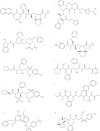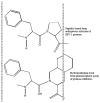HIV Protease Inhibitors: Effect on the Opportunistic Protozoan Parasites
- PMID: 21629510
- PMCID: PMC3103880
- DOI: 10.2174/1874104501105010040
HIV Protease Inhibitors: Effect on the Opportunistic Protozoan Parasites
Abstract
The impact of highly active antiretroviral therapy (HAART) in the natural history of AIDS disease has been allowed to prolong the survival of people with HIV infection, particularly whose with increased HIV viral load. Additionally, the antiretroviral therapy could exert a certain degree of protection against parasitic diseases. A number of studies have been evidenced a decrease in the incidence of opportunistic parasitic infections in the era of HAART. Although these changes have been attributed to the restoration of cell-mediated immunity, induced by either non-nucleoside reverse transcriptase inhibitors or HIV protease inhibitors, in combination with at least two nucleoside reverse transcriptase inhibitors included in HAART, there are evidence that the control of these parasitic infections in HIV-positive persons under HAART, is also induced by the inhibition of the proteases of the parasites. This review focuses on the principal available data related with therapeutic HIV-protease inhibitors and their in vitro and in vivo effects on the opportunistic protozoan parasites.
Keywords: Protease inhibitors; antiretrovirals; parasite; protozoa; therapeutic agents.
Figures



References
-
- Palella F, Delaney K, Moorman AC, Loveless MO, Fuhrer J, Satten GA, Aschman DJ, Holmberg SD. Declining morbidity and mortality in an ambulatory HIV-infected population. N. Engl. J. Med. 1998;338:853–60. - PubMed
-
- Babiker A, Darbyshire J, Pezzotti P, Porter K, Rezza G, Walker SA, Beral V, Coutinho R, Del Amo J, Gill N, Lee C, Meyer L, Tyrer F, Dabis F, Thiebaut R, Lawson-Aye S, Boufassa F, Hamouda O, Fischer K, Pezzotti P, Rezza G, Touloumi G, Hatzakis A, Karafoulidou A, Katsarou O, Brettle R, del Romero J, Prins M, van Benthem B, Kirk O, Pederson C, Hernández Aguado I, Pérez-Hoyos S, Eskild A, Bruun JN, Sannes M, Sabin C, Lee C, Johnson AM, Phillips AN, Francioli P, Vanhems P, Egger M, Rickenbach M, Cooper D, Kaldor J, Ashton L, Vizzard J, Muga R, Day NE, De Angelis D. Changes over calendar time in the risk of specific first AIDS-defining events following HIV seroconversion, adjusting for competing risks. Int. J. Epidemiol. 2002;31:951–8. - PMC - PubMed
-
- De Clercq E. Anti-HIV drugs: 25 compounds approved within 25 years after the discovery of HIV. Int. J. Antimicrob. Agents. 2009;33:307–20. - PubMed
-
- Monkemuller KE, Call SA, Lazenby AJ, Wilcox CM. Declining prevalence of opportunistic gastrointestinal disease in the era of combination antiretroviral therapy. Am. J. Gastroenterol. 2000;95:457–62. - PubMed
-
- Mastrolorenzo A, Rusconi S, Scozzafava A, Barbaro G, Supuran CT. Inhibitors of HIV-1 protease: current state of the art 10 years after their introduction. From antiretroviral drugs to antifungal, antibacterial and antitumor agents based on aspartic protease inhibitors. Curr. Med. Chem. 2007;14:2734–48. - PubMed
LinkOut - more resources
Full Text Sources
